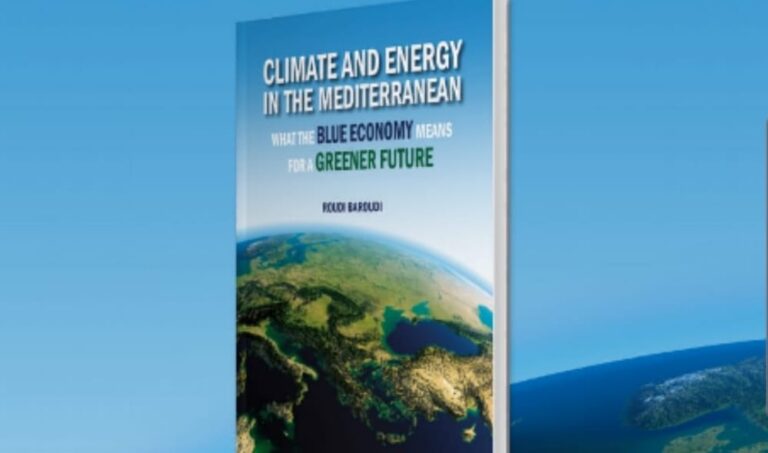اتفاية ترسيم الحدود البحرية مع قبرص
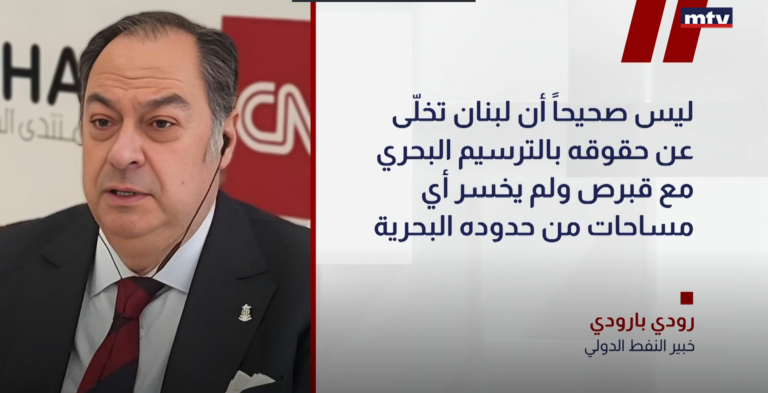


المركزية- يُظهر الاكتشاف الأخير للغاز في حقل “كاريش” الواقع في جنوبي لبنان، بغاية الوضوح أن على لبنان فعل كل ما في وسعه ليمهّد الطريق أمام صناعة النفط والغاز البحرية الخاصة به، وعلى وجه التحديد من خلال تسوية الحدود البحرية مع قبرص وسوريا، وفقًا لأحد أهم الخبراء في المنطقة في مجال الطاقة.
وفي مقابلة عقب إعلان شركة إنرجيان اليونانية – الإسرائيلية عن اكتشاف ثانٍ في حقل “كاريش” المتاخم للمياه اللبنانية، يكشف خبير الطاقة الدولي رودي بارودي الذي يتمتع بخبرة تزيد عن أربعة عقود في مجال الطاقة، أن “هذه الأخبار جيّدة بالنسبة إلى لبنان”.
ويقول بارودي، الذي يشغل حاليًا منصب الرئيس التنفيذي لشركة الطاقة والبيئة القابضة وهي شركة استشارية مستقلة مقرها في الدوحة – قطر، لـ”المركزية”: ليس مستغرباً أنهم وجدوا المزيد، فذلك يؤكد ما كنا نعرفه منذ سنوات عدة. ولم نتمكن من تحديد موقع جميع الموارد الموجودة في قاع بحر شرق المتوسط، بما في ذلك الرواسب النفطية التي تنتظر الاكتشاف قبالة سواحل لبنان. المشكلة أن المأزق السياسي المعقّد الذي يعيشه لبنان قد تسبّب بتأخيرٍ كبير في تطوير قطاع الهيدروكربونات البحرية الناشئ في البلاد”.
ويؤكد أن “الاكتشاف الجديد يقع بالقرب من خط الحدود البحري (MBL) الذي اتفق عليه لبنان وإسرائيل في تشرين الأول/ أكتوبر 2022″، ويوضح أن “هذا الاتفاق الذي تم التوصل إليه بعد وساطة استمرت سنوات من قِبَل الولايات المتحدة، كان “خطوة ضرورية”، لكنه لم يكن كافياً وحده لتنشيط صناعة النفط والغاز في لبنان وتفعيلها بشكل كامل”.
ورداً على سؤال عن كيفية المضي قدماً في بيروت في هذه المرحلة، يشدد بارودي على “أهمية التقدّم في الجهود الرامية إلى وضع اللمسات النهائية على اتفاقات ترسيم الحدود البحرية بين لبنان وقبرص وبين لبنان وسوريا، والتي من شأنها أن تحقق اعترافاً دولياً كاملاً بالمنطقة الاقتصادية الخالصة للبنان، وبالتالي تقليل المخاطر التي تواجهها شركات النفط الكبرى التي يحتاج لبنان إلى خبرتها ومساعدتها للتمكن من إجراء عمليات استكشاف واستغلال موارده البحرية بشكل مفيد وكامل”.
ويُضيف: لقد تفاوضنا سابقاً على ترسيم الحدود البحرية مع قبرص، لكن المجلس النيابي اللبناني لم يصادق على الاتفاقية. وهذا يعني أنه يتعيّن علينا أن ننطلق من النقاط المتَّفق عليها في المباحثات السابقة وأن نُضيف إليها بعض الإحداثيات من أجل تحديد نقطة تقاطع ثلاثية حيث تتقاطع خطوط الحدود البحرية اللبنانية والقبرصية والإسرائيلية في البحر. وتحديد هذا المثلث في الجنوب سيبسّط تلقائياً عملية تحديد مثلث آخر في الشمال بين لبنان وقبرص وسوريا.
وفي السياق، يقلل بارودي من شأن المزاعم التي تتحدث عن وجود فجوة كبيرة بين الخط اللبناني – القبرصي والخط القبرصي – الإسرائيلي، مما يزيد من صعوبة تحديد الخط الثلاثي. ويقول: هناك فجوة بالطبع، لكنها في الحقيقة صغيرة جدًا. والدليل على ذلك هو ترسيم حدود المناطق البحرية التي أصدرها كل من لبنان وقبرص منذ حوالي عقد من الزمن. إضافة إلى أن جميع الخرائط الدولية للمنطقة، بما في ذلك تلك الصادرة عن شركات النفط والغاز والتي ترتكز في الأصل على تصوير دقيق للحدود والمساحة، لا تؤشر إلى أي تداخل بين لبنان وقبرص. في الواقع، إن الخط الفاصل بين الكتل اللبنانية والقبرصية يتبع بدقة خط ترسيم الحدود البحرية MBL المتفق عليه والذي وافقت عليه نيقوسيا وبيروت في الاتفاقية التي لم يتم المصادقة عليها. أما الفرق في الجانب الجنوبي من نقطة التقاطع فهو صغير جدًا.
ويُضيف: نظراً إلى أن الخطوط قريبة جداً، فإن تحديد تقاطع ثلاثي – النقطة التي تتقاطع فيها الحدود اللبنانية والقبرصية والإسرائيلية – يجب أن يكون سهلاً نسبياً. بالإضافة إلى ذلك، فإن الاتفاق على هذا التقاطع الثلاثي في الجنوب من شأنه أن يبسّط تلقائياً عملية تحديد تقاطع ثلاثي في الشمال بين لبنان وقبرص وسوريا. من دون أن ننسى أن لبنان يتمتع بعلاقات ودية وقوية مع كل من قبرص وسوريا، وبالتالي فإن المفاوضات معهما ستكون أكثر وديّة من تلك التي جرت مع إسرائيل، والتي كان لا بد من متابعتها بشكل غير مباشر عبر وساطة أميركية.
ولدى سؤاله عن كيفية تأثر أي جهود ديبلوماسية جديدة لترسيم الحدود البحرية، بالشلل السياسي المستمر منذ فترة طويلة في بيروت، حيث يعاني لبنان من شغور في رئاسة الجمهورية منذ أواخر العام 2022 لأن البرلمان اللبناني لم يستطع انتخاب خلف للرئيس السابق ميشال عون، يُجيب بارودي: هذا المأزق يؤكد ضرورة اتخاذ إجراءات جديدة.
ويقول: صحيح أن لبنان لا يستطيع في الوقت الحالي، المصادقة رسميًا على اتفاقية ترسيم حدود بحرية MBL جديدة مع قبرص أو سوريا لأنها تتطلب توقيع رئيس الجمهورية عليها، لكن هذا لا يمنعنا من إجراء المحادثات التقنية اللازمة. في الواقع، يجب أن نسارع إلى تسوية كل هذه الأمور الآن، حتى عندما نملأ المنصب الشاغر في قصر بعبدا، يكون كل شيء جاهزاً لتوقيع الرئيس الجديد.
وإلى جانب تسوية حدوده البحرية، يقول بارودي إن “لبنان لديه أيضًا سبب آخر لتفعيل المفاوضات مع الدول المجاورة”، ويذكر في هذا المجال: مرّ ما يقارب العشر سنوات منذ أن اقترحت قبرص اتفاقية تنمية مع لبنان للإنتاج المشترك من أي مخزونات موجودة على الحدود البحرية المشتركة. وهذا الأمر مهم جداً للبنان وللصناعة النفطية فيه، وللأسف فقد حال الشلل السياسي اللبناني دون حدوث ذلك. بالفعل نحن بحاجة إلى إحياء هذه العملية والتوصل إلى اتفاق في أسرع وقت ممكن.
…”في حال البدء بهذه العملية وبمجرد أن يكون لدينا رئيساً للجمهورية، نكون مستعدين للانطلاق بسرعة من دون مزيد من التأخير، والبدء بجَمع عائدات الغاز التي يحتاج إليها الاقتصاد اللبناني بشدة” يختم بارودي.
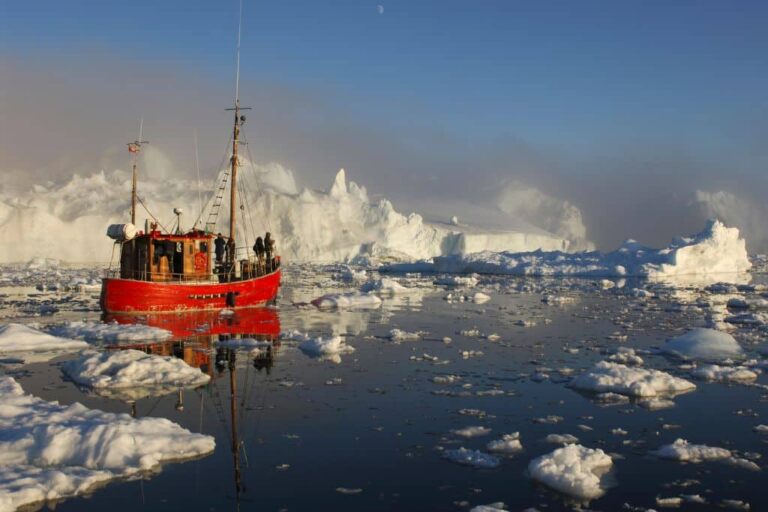
Aggravating concerns about global warming and its consequences, a new, comprehensive analysis of satellite data has found Greenland has lost more ice than previously estimated and that the majority of glaciers on the landmass have retreated significantly. The Greenland Ice Sheet has shed about one-fifth more ice mass in the past four decades than previously estimated, researchers at Nasa’s Jet Propulsion Laboratory in Southern California reported in a new paper. Icebergs are falling into the ocean at an accelerating rate. Though this additional ice loss has had only an indirect impact on sea levels, it could hold implications for ocean circulation in the future.
Published in Nature on January 17, the analysis offers a comprehensive look at retreat around the edges of the entire ice sheet from 1985 to 2022, drawing from nearly a quarter million pieces of satellite data on glacier positions. Of the 207 glaciers in the study, 179 retreated significantly since 1985, 27 held steady, and one advanced slightly. Most of the ice loss came from below sea level, in fjords on Greenland’s periphery. Once occupied by ancient glacial ice, many of these deep coastal valleys have filled with seawater – meaning the ice that broke off made little net contribution to sea level. But the loss likely accelerated the movement of ice flowing down from higher elevations, which in turn added to sea level rise.
“When the ice at the end of a glacier calves and retreats, it’s like pulling the plug out of the fjord, which lets ice drain into the ocean faster,” said Chad Greene, a glacier scientist at JPL and the study’s lead author. For decades researchers have studied the Greenland Ice Sheet’s direct contributions to global sea level rise through ice flow and melting. Scientists participating in the international Ice sheet Mass Balance Inter-comparison Exercise (IMBIE) estimated that the ice sheet had lost 5,390 billion tonnes between 1992 and 2020, adding about 13.5 millimetres to global mean sea level, according to the Intergovernmental Panel on Climate Change. But the IMBIE measurements do not account for ice lost due to the retreat of terminal glaciers along the edges of Greenland. (These glacier edges were already in the water, whether submerged or floating.) The new study quantifies this amount: For the 1985 to 2022 period in the new paper, the ice sheet was estimated to have lost about 1,140 billion tonnes – 21% more mass lost than in the IMBIE assessment.
Although it doesn’t add to sea levels, the additional ice represents a significant influx of fresh water to the ocean. Recent studies have suggested that changes in the salinity of the North Atlantic Ocean from melting icebergs could weaken the Atlantic Meridional Overturning Circulation, part of the global “conveyor belt” of currents that transport heat and salt around the ocean. This could influence weather patterns worldwide, as well as affect ecosystems, the authors said.
Icebergs have tumbled from Greenland’s glaciers for thousands of years as part of a natural cycle that typically balanced glacier growth in the winter with melting and retreat in the summer. The new study finds that ice retreat has far outpaced growth throughout the 21st century. The researchers also found that Greenland’s ice extent remained relatively steady from 1985 to 2000, then started a marked recession that continues to this day.
The data showed a glacier in northeast Greenland called Zachariae Isstrom lost the most ice, dropping 176 billion tonnes of mass due to retreat. It was followed by Jakobshavn Isbrae on the western coast, which lost an estimated 97 billion tonnes and Humboldt Gletscher in the northwest, which lost 96 billion tonnes. Only one glacier, Qajuuttap Sermia in southern Greenland, experienced any growth over the study period, but its gains were too small to offset the losses from other glaciers.
The researchers also found that glaciers with the largest seasonal fluctuations in the position of their ice front experienced the greatest overall retreat. The correlation suggests the glaciers that are most sensitive to warming each summer will be most impacted by climate change in the coming decades.


While the world population reached 8bn on November 15, 2022 according to the United Nations, nearly 3.6bn people are now climate vulnerable. It is in this context that one should analyse the news that the Intergovernmental Panel on Climate Change (IPCC) Synthesis Report under the Sixth Assessment Cycle will be released on March 20 following negotiations this week by governments on the ‘Summary for Policymakers’.
The report will gather and distil scientific evidence from the IPCC working group reports and special reports published between 2018 and 2022. It will be the last such report from the IPCC in this cycle until further reports are published under the next assessment cycle, which could be only in 2027 or 2028.
Culminating with this Synthesis Report, the science from the IPCC is crucial evidence to governments for this decade on the current state of the climate crisis. It must serve as a warning to polluters that their time is up. The window of time to keep global temperatures below 1.5ºC is fast closing in. Current climate targets put the world on a 2.8ºC pathway by 2100. A rapid equitable fossil fuel phase out must be top priority for all governments while scaling up investments in renewables and energy efficiency measures. Wealthy nations must substantially increase their international climate finance based on their fair share, the Climate Action Network (CAN) has urged in a statement last Friday.
Past reports under this assessment cycle have underlined the dire situation and stated unequivocally that greenhouse gases – from the reliance on fossil fuels, industrialisation and land-use – is driving up emissions and causing unprecedented levels of global heating. Human actions have caused the last decade to be the warmest decade in the last 125,000 years. Sharpening inequities show that the richest 10% of households contribute about 36%-45% of global greenhouse gas emissions. Communities in many vulnerable regions will experience the limits of adaptation even before 1.5ºC warming and sea-level rise poses an existential threat to some small islands and low-lying coastal areas.
“The forthcoming IPCC report should mobilise governments to envision and act towards transitioning into a fully renewable-energy powered society supported by strong energy efficiency measures, based on principles of justice and the protection of human rights,” stated Stephan Singer, senior global specialist on climate science and energy, CAN International, and head of delegation for CAN at IPCC. Investing in renewables means rapidly divesting from fossil fuels and nuclear energies and phasing them out by mid-century to ensure the least damaging pathway towards climate stability. The IPCC Synthesis Report must reiterate its recent findings that renewable energy, particularly solar and wind, are technologically, financially and economically the key means to fight climate change, he said.
Dr Stephen Cornelius, Global Deputy Lead for Climate and Energy, World Wide Fund for Nature, stated that leaders must heed the science and act immediately with the pace and scale necessary to decarbonise the economies in time. An accelerated phase-out of fossil fuels is needed to limit global warming to below 1.5ºC and avoid the worst climate change risks. As he explained, nature is our secret ally in the fight against climate change. Natural systems have absorbed 54% of human-related carbon dioxide emissions over the past decade and have slowed global warming and helped protect humanity from much more severe climate change risks. We can’t hope to limit warming to 1.5°C, adapt to climate change and save lives and livelihoods, unless we also act urgently to safeguard and restore nature, a non-negotiable part of the solution to the climate crisis, as Dr Cornelius said.

The $6bn proposed ethane cracker at Ras Laffan, which is QatarEnergy’s largest investment ever in country’s petrochemical sector, marks an important milestone in its downstream expansion strategy.
The petrochemical complex will not only facilitate further expansion in Qatar’s downstream and petrochemical sectors, but will also reinforce the country’s integrated position as a major global player in the upstream, LNG and downstream sectors.
The Ras Laffan Petrochemicals complex, expected to begin production in 2026, consists of an ethane cracker with a capacity of 2.1mn tonnes of ethylene per year.
The 435-acre project site also includes two polyethylene trains with a combined output of 1.7mn tonnes per year (mtpy) of high-density polyethylene (HDPE) polymer products.
This will raise Qatar’s overall petrochemical production capacity to almost 14mn tonnes per year, HE the Minister of State for Energy Affairs, Saad bin Sherida al-Kaabi, told Gulf Times.
QatarEnergy has joined hands with Chevron Phillips Chemical Company (CPChem) on the projected and created a joint venture,
in which QatarEnergy will own a 70% equity share, and CPChem 30% stake.
Together their large and diverse portfolio will not just help meet the world’s growing needs for advanced plastics and petrochemicals, but will also enable balanced growth and facilitate human development in a responsible and sustainable manner.
QatarEnergy and Chevron Phillips Chemical Company (CPChem) have taken a Final Investment Decision (FID) on the Golden Triangle Polymers Plant, an $8.5bn world-scale integrated polymers facility in the Texas Gulf Coast area in the US.
The Ras Laffan petrochemicals complex will help meet the rising global demand for high-density polyethylene from 2026, when the largest ethane cracker in the Middle East and one of the largest in the world begins production.
Polyethylene is used in the production of durable goods like pipe for natural gas and water delivery and recreational products such as kayaks and coolers. It is also used in packaging applications to protect and preserve food and keep medical supplies sterile.
The facility will be constructed with modern, energy-saving technology and use ethane for feedstock, which along with other measures, is expected to result in lower greenhouse gas emissions than similar global facilities.
The integrated olefins and polyethylene facility will be utilising “state-of-the-art design and technology” during its construction and operation to promote energy efficiency.
It is important to stress the unique environmental attributes of this world-scale complex. It will have lower waste and greenhouse gas emissions, when compared with similar global facilities.
Already, QatarEnergy made significant strides in realising the North Field Expansion by choosing partners this year for both North Field South (NFS) and North Field East (NFE) expansion, which is the global industry’s largest ever LNG project.
This unique project is characterised by the highest health, safety, and environmental standards, including carbon capture and sequestration, to reduce the project’s overall carbon footprint to the lowest levels possible.
The North Field expansion plan includes six LNG trains that will ramp up Qatar’s liquefaction capacity from 77 mtpy to 126 mtpy by 2027.
Four trains will be part of the North Field East and two trains will be part of North Field South project.

الراعي تسلّم من رودي بارودي أول دراسة من نوعها حول ترسيم الحدود
ومجسم “الفيفا” لكأس العالم في كرة القدم للعام 2022
استقبل البطريرك الماروني مار بشارة بطرس الراعي خبير الطاقة الدولي الدكتور رودي بارودي، وإستبقاه الى مائدة الغداء. وكان عرض الاوضاع الراهنة، وقدم بارودي للراعي اول دراسة من نوعها حول ترسيم الحدود البحرية بين لبنان وإسرائيل والتي كان عرضها في ندوته الأخيرة في جامعة سيدة اللويزة، كما قدم له مجسم “الفيفا” لكأس العالم في كرة القدم التي إنطلقت اليوم في دولة قطر.
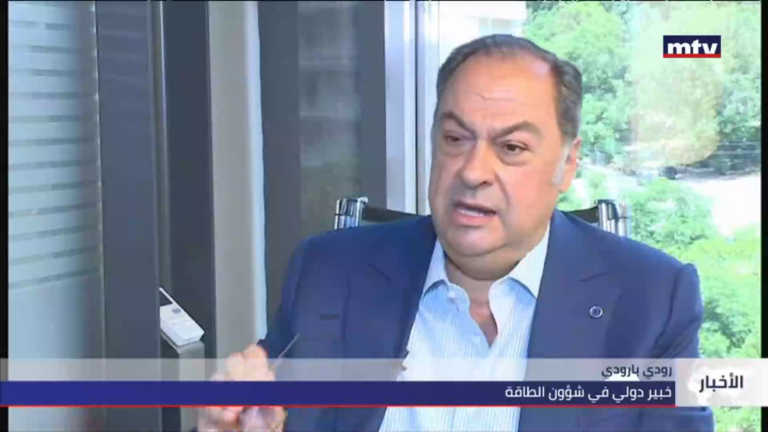
بارودي يؤكد صوابية طلب لبنان الخاص بالمباحثات والمفاوضات على الحدود البحرية ويؤكد صوابية طلبه مستعيناً بقضايا مماثلة حصلت في السابق وتم البت بها من قبل محكمة العدل الدولية
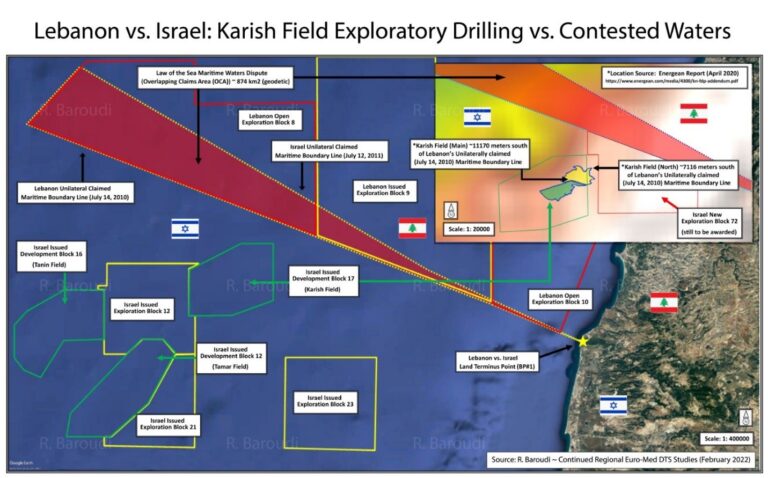

كَثُرَت في الفترة الأخيرة الخيارات المتاحة في نظر بعض المسؤولين في لبنان، لتأمين مصادر يتم عبرها تسديد أموال المودِعين… فما أن طُرِح إنشاء الصندوق السيادي، حتى ارتأى البعض اللجوء إلى رهن جزء من احتياطي الذهب… لكن ما لم يكن في الحسبان أن يقترح أحدهم استخدام أموال ثروة لبنان النفطية لتسديد الودائع ولتغطية كلفة الدين العام! علماً أن مفاوضات ترسيم الحدود البحرية بين لبنان وإسرائيل عالقة منذ أيار 2021، ولا تزال الضبابية تلف هذا الملف محلياً ودولياً.
الخبير الدولي في مجال الطاقة رودي بارودي يعلّق, في حديث إلى موقع القوات اللبنانية الإلكتروني، على الفائدة المالية من حقول النفط التي يؤمَل أن تشكّل الثروة النفطية للبنان، ليؤكد أنه “في حال حصول لبنان على جزء من حقل كاريش, فإن حصته لا تكفي لتغطية الدين العام اللبناني حتى وفق أسعار النفط والغاز المعتمدة حالياً”، ويقول “ربما قد تغطي حصّة لبنان من حقل كاريش أو غيره، جزءاً ضئيلاً فقط من الدين العام”.
ويعتبر أنه “من غير المؤكد ما إذا كان لبنان سيتمكّن من الحصول على الخط 23، من دون معالجة مجموعة من الأخطاء الجسيمة التي ارتُكِبَت عند البدء بوضع الخطوط من 1 الى 23 قبل نحو 12 عاماً”.
ويكشف بارودي عن أن حقل “كاريش” المكتشَف العام 2013 يحتوي على 2.5 ترليون قدم مربّع من الغاز. وهذا الحقل تم اكتشافه من قبل الشركة الإسرائيلية “ديليك” العام 2013 والتي باعته بدورها إلى “إينيرجيان”.
ويقول، إذا تم احتساب الكمية على أساس أسعار الغاز والنفط الحالية، فإن المردود المتوقع من حقل “كاريش” يتراوح ما بين 22 و25 مليار دولار أميركي. لكن لا يمكن تقدير مردود حقل “قانا” لأنه قد يكون ممتداً إلى إسرائيل، كما أن حقل “كاريش” متداخل بين لبنان وإسرائيل.
ويُلفت إلى أن إسرائيل أنجزت التحضيرات اللازمة لبدء الإنتاج النفطي وذلك بعد أعوام عدة من الدراسات وعمليات الاستكشاف، فقد عاودت شركة “إينيرجيان” المطوِّرة لحقل “كاريش” الحَفر في الحقل ذاته بحثاً عن المزيد من الغاز والنفط، ويوضح أن “إسرائيل تقوم حالياً بالحَفر في محاذاة الخطّ اللبناني التفاوضي “29” لتنتقل بعد ذلك إلى شمال “كاريش”.
ويُذكِّر في السياق بأن “لبنان أعلن في رسالَتَيه إلى الأمم المتّحدة الأولى في 22 أيلول 2021 والثانية في 28 كانون الثاني 2022، أن حقل كاريش يقع في منطقة متنازع عليها… لكن على الرغم من ذلك، يتم التنقيب في المياه المتنازَع عليها عموماً، ولا سيما في البلوك رقم “9” المُعطّل حالياً إلى أن تُحّل قضية الترسيم بين لبنان وإسرائيل”.
أما بالنسبة إلى الموقع الجغرافي لحقل “كاريش” المكوَّن من جزءين: شمالي وجنوبي (الخريطة مرفقة)، يؤكد بارودي من خلال الدراسة التي أعدّها خلال السنوات الممتدة من العام 2011 إلى العام 2021، أن “حقل كاريش الشمالي يَبعد عن الخط المقترح من قبل لبنان في 14 تموز 2010 (الخط 23) حوالي 7 كلم و116 متراً، كما أن حقل كاريش الجنوبي يَبعد عن الخط نفسه، حوالي 11 كلم و170 متراً جنوباً، وذلك بحسب الخريطة المرفقة والتي تؤكد المواقع والبُعد عن الحَقلين”.
أما بالنسبة إلى البلوك الإسرائيلي الرقم “72” والمتداخل في الأراضي اللبنانية، فهو ملاصق بشكل مباشر للخط “23”، بحسب بارودي.
